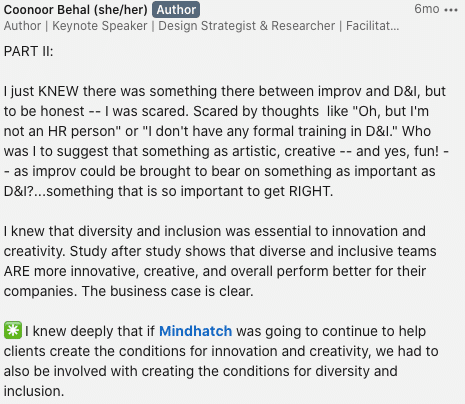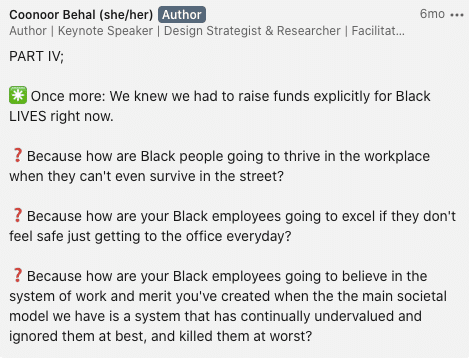
tokenism—the practice of making only a symbolic effort to promote equity in the workplace by filling quotas.
Along with being woman of color myself and a staunch anti-racist, the innovative potential inherent in recognizing and hiring people from a variety of backgrounds is a big reason why I decided to add Diversity and Inclusion services to Mindhatch’s offerings. Study after study shows that more diverse and inclusive teams are more innovative. And yet, in trying to address internal inequities and unlock more creativity, many organizations unintentionally fall into the trap of tokenism—or the practice of making only a symbolic effort to promote equity in the workplace by filling quotas.
In other words, they give their company the look of diversity, without actually achieving it fundamentally. Tokenism actually masks inactivity and stagnancy within a company because it merely looks “on paper” as if the company is doing better on the diversity front. It also doesn’t ensure that people of color are being retained, let alone being hired into positions of power, where they can impact vital decision-making.
Forbes reports, “While many companies are focused on diversity they neglect the importance of inclusion. Diversity and inclusion go hand-in-hand. Companies can hire diverse talent and celebrate ticking the box, but if the people they hire don’t feel included or supported they’ll quickly become disengaged and are more likely to leave.”
That said, after a tumultuous 2020, interest in implementing more authentic and effective Diversity and Inclusion (D&I) strategies in the workplace is at an all-time high. With the onset of the coronavirus in March, hiring for such Diversity & Inclusion roles as “Chief Diversity Officer” actually plummeted by 60%, according to new data from the hiring site Glassdoor. But with the social uprising and racial reckoning prompted by the murder of George Floyd by police, job postings with “diversity,” “inclusion,” and/or “equity” in the title rebounded by 55%. This was largely due to pressure from current employees who were dissatisfied with their company’s response to the racial injustice and approach to D&I within their own companies.
To folks who expressed dissatisfaction, I say—good on you. Not only is anti-racism a moral obligation, it’s absolutely key for business innovation and growth, as I wrote on LinkedIn earlier this year when our White Privilege, Black Power show decided to do a fundraiser for Black lives:
“Diversity is a key driver of innovation and is a critical component of being successful on a global scale.” – Forbes Insights
Though fostering true Diversity, Inclusion and Equity can be challenging, and each of these pillars addresses a unique yet interrelated goal, there are ways to avoid and transform policies that merely tokenize and leverage the innovative potential diversity gives your business.
Here are a few of Mindhatch’s favorite strategies to avoid tokenization while prioritizing innovation:

Use A Fresh Approach to Diversity Hiring
Tokenism usually stems from outdated hiring practices that put too much emphasis on the judgement of a single manager. In this context, people can often be defined and singled out for their marginalized identities rather than their skills, which then affects the nature of their hiring experience. By reviewing and updating potential weaknesses in your hiring processes, and working to rely on data-driven hiring practices rather than the biased instinct of one hiring manager, companies can foster lasting workplace equity.
For instance, using data-driven candidate qualification in your hiring process, such as pre-hire assessments, can help minimize bias, according to Modern Hire, because then decisions rest on data and not innate human bias. Another way to do this is to hold team-oriented hiring processes. Though this can sometimes result in long, multi-part interviews for the candidates, the more perspectives you have the less likely it will be that one person’s bias sways a hiring decision.
“Companies who are intentional about hiring, retaining and developing diverse talent are 35% more likely to outperform their competitors.
Data-driven hires also tend to be better quality hires overall, and offer companies cognitive diversity—both of which are vital for innovation and good business. According to Forbes, “Companies who are intentional about hiring, retaining and developing diverse talent are 35% more likely to outperform their competitors. This is because diversity brings together different cultures, races, genders, generations and backgrounds to provide new perspectives, ideas and solutions.”

Invest in Diversity Education and Initiatives
Many companies are frantically trying to improve their diversity and inclusion statistics in order to garner favorable public opinion—but when it comes to fostering real diversity, equity, and inclusion, doing it for appearances isn’t enough – and only results in tokenization. That change must happen in the company’s internal culture, and within each individual employee’s understanding of racial injustice.
This is where diversity and inclusion training and experiences like Mindhatch’s White Privilege Black Power, can come in to transform the attitudes and awareness of your team. For example, Harvard Business Review put together an experiment to measure the impact of diversity training. After administering 3 online training courses—one about gender-bias, one about bias of all sorts, and a third control test that didn’t include mention of bias—they found that their efforts had a major impact on the attitudes of employees, particularly employees who’d shown a bias against women.
“After completing training, these employees were more likely to acknowledge discrimination against women, express support for policies designed to help women, and acknowledge their own racial and gender biases, compared to similar employees in the control group,” the study reported.
Similarly, Science for Work found that diversity training “strongly enhances” people’s knowledge about other groups and how they behave towards others. For long-term lasting effects on company culture, Science for Work also found that “implementing other diversity-related initiatives simultaneously with the training amplifies its effects on beliefs and behaviors, also helping them last in time.”

Create a Workplace Where Diversity Belongs
In order to attract the sort of talent you’re looking for, you need to create the sort of workplace that people of diverse backgrounds would feel comfortable and happy in—sometimes long before you’ve been able to create the heterogeneous workforce you desire. This is essential because fostering equity in the workplace is about making diverse hires, but also about inclusion—creating welcoming, empathetic spaces. Without the second piece, it’s likely you won’t be able to retain a diverse workforce.
Therefore, beyond training employees to understand and empathize with peers of different backgrounds, offering benefits that accommodate other ways of life—like wheelchair ramps, maternity and paternity leave, flexibility around taking time off for non-Christian holidays—prime your company for enhanced diversity, inclusion, and equity.
With all this in mind, I still understand that encouraging more equity in a workplace can seem like a daunting and impossibly nuanced task. Though the stakes may seem high, the effort is worth it.
No matter where you are in your journey toward diversity, equity, and inclusion, Mindhatch’s expertise in strategic innovation and diversity and inclusion can point your compass toward true workplace equity and teach you how to harness—and celebrate—difference.



